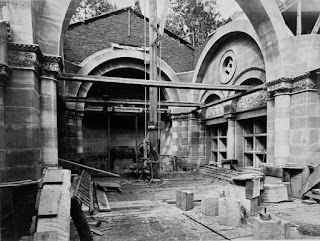While I was in Newport, Rhode Island, I visited a bookstore
and bought a book about the history of the Vanderbilt family. I had heard of Commodore Cornelius Vanderbilt who had amassed the wealth, and the
Vanderbilt name was linked with rich elite, but the name was not as commonly
referred to as Rockerfeller or Roosevelt so I didn’t know much of anything
about them. Perhaps if Grand Central
Station had been named Vanderbilt Center, they’d still be more in the forefront.
What I learned was that Cornelius Vanderbilt was born and
raised on a farm on Staten Island. When
he was a teenager, he worked a ferry service shuttling people and produce from
the farms on Staten Island to various docks in Manhattan. While continuing his ferry service, he went
to work managing the steamboat service of Thomas Gibbons who wanted to drive
his competition to either sell out to him or go out of business.
Cornelius to New Jersey with his wife Sophia, also his first
cousin, and she opened a profitable inn there.
For the California Gold Rush, Vanderbilt turned to ocean shipping. Then he bought the stock of the Harlem
Railroad, made it profitable, and the rest is history..
The competitiveness was passed through the generations – his
grandson Cornelius II bought the block on Fifth Avenue between 57th
and 58th Streets to build the biggest house ever constructed in the
US. And why? Because he wanted to outdo his friends and
neighbors. By contrast, the amasser of
the
 |
| Commodore Cornelius Vanderbilt House 10 Washington Place, NY |
wealth, the Commodore moved from New Jersey to a relatively moderate home
at 10 Washington Place (torn down to build a 6-story commercial building in
1900) which is now owned by NYU. I was
there while it was being renovated and took a walk inside.
After his first wife (Sophia) died in 1868, Commodore
Vanderbilt eloped in 1869 with another cousin, 43 years his junior. Her name was Frank Armstrong. A year later he financially sponsored
Victoria Woodhull and her sister Tinny in become members of the New York Stock
Exchange. There were rumors that
Vanderbilt had an affair with Tinny, also much younger than he. The Woodhulls made a fortune on Wall Street
and started their newspaper Woodull & Clafflin’s Weekly which published the
first English version of Communist Manifesto by Karl Marx. Did the Commodore read it, I wonder.
Commodore Vanderbilt donated land to the Moravian Church in
Staten Island and that is where he and some other members of his family are
buried. I wanted to see it, so I took a
trip over to Staten Island.
I only visited Staten Island twice while I lived in
Brooklyn. I drove across the Verrazano
Narrows Bridge (this is the bridge in Saturday
Night Fever) just for fun and was surprised when I was charged a hefty toll
to get back to Brooklyn. The second visit,
I took the ferry from Manhattan. Staten
Island doesn’t have a subway (underground), but it does have a train which I
took to the New Dorp stop and walked up to the cemetery. The feeling being there was like a fishing village. The area isn't as densely populated or over-constructed as the other boroughs, and the feeling is lighter, newer.
I knew from the book that the Vanderbilt Mausoleum was at
the rear of the cemetery and so that’s where I headed. At the back, I passed a vaulted exit with
locked iron gates and couldn’t find the Vanderbilts. I asked some people in the cemetery and they
directed me back to that vaulted exit.
That was the entrance to the Vanderbilt portion of the cemetery. I found my way passed the gate and into a
weird, silent, dead feeling. I walked about
a quarter of a mile up a narrow road, passing lots of fallen dead trees and not
seeing or hearing a living creature – not a bird or squirrel – the whole way.
 |
| Vanderbilt Tomb Interior |
At the top, the feeling was creepy. The Vanderbilt Mausoleum resembles a small
church with three sets of doors at the front and small vaulted windows above
them. At one time the doors were iron
gates, but in the 1960s a woman pulled on the gates trying to get inside the
tomb and the gates fell on her and killed her.
So, the gates have been replaced with gray steel industrial doors with
padlocks. The windows above the doors
have been stopped up with concrete blocks.
It is difficult to describe the feeling – sadness,
loneliness, desolation. But certainly the
place felt empty. I didn’t linger. I would never want to go back there.
It was only when I was walking back down through the
cemetery that I realized I was walking on the farmland where Cornelius
Vanderbilt grew up.





